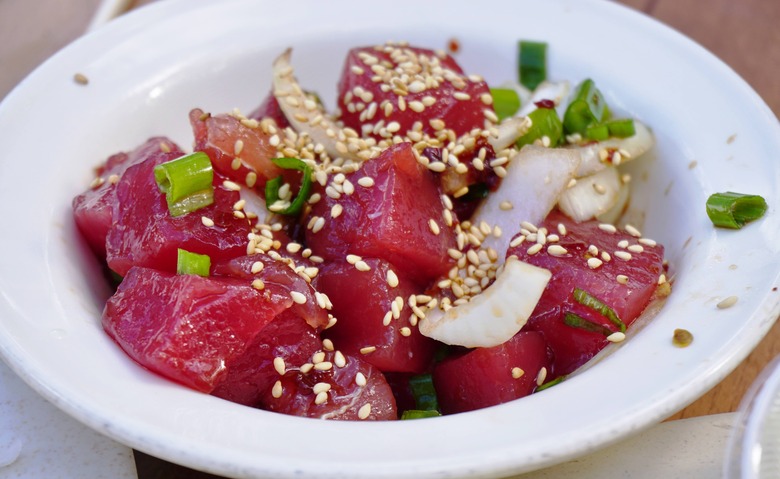What Is Hawaiian Poke, And Why Is It The Latest Mainland Food Fad?
If you pay attention to food trends, you may have noticed that poke is the newest fad. Of course, Hawaiians will tell you there's really nothing new about it — poke, in its present form, has been around since at least the 1970s. But what exactly is this dish, and why is it suddenly so popular?
Poke (pronounced "poh-kay," not "poke") is a raw fish salad that is served as an appetizer, or can be consumed as a meal by itself. Traditionally, there are two forms of poke: aku (oily tuna) and tako (octopus) — but ahi poke (made with yellowfin tuna) is becoming increasingly common. Variations with salmon or shellfish can also be found. The signature of this dish, however, is the fact that the seafood in it is served raw.
To prepare the dish, the fish must first be gutted, skinned, and deboned. It is then fileted across the backbone (poke comes from the Hawaiian verb for "to section, slice, or cut") and seasoned with Asian-influenced additions, like soy sauce, green onions, sesame oil, seaweed, furikake (dried fish, sesame seeds, and dried seaweed), chiles, sea salt, inamona (roasted and crushed candlenut), fish eggs, wasabi, and/or Maui onions. In Hawaii, the most common seasonings are soy sauce and sesame. Since the fish is sliced into cubes, it can easily be mixed, however, with whatever ingredients the consumer prefers.
Although the current form and name may have only been around for 50 or 60 years, a dish resembling poke has been consumed in Hawaii since before the arrival of Captain Cook in the mid-1700s, and was likely invented by sailors looking to utilize pieces from their catches as a snack that didn't require cooking. Or it may simply be an old Hawaiian spin on sashimi. Regardless, it's more popular now than ever, likely due to the general increase of acceptance of raw fish in Western culture. A few decades ago, sushi wasn't very common in America, but now it can be found in countless restaurants, most grocery stores, and even some gas stations and bodegas. This is the exact path poke is currently following (yes, even the gas station part).
Poke is also a quick, easy, and relatively cheap meal (especially when served over rice), which bodes well for today's ultra-busy, cost-conscious Americans. Just chop, mix, and eat.
Hungry yet? Luckily, there are plenty of places to buy poke nowadays (outside of Hawaii's Da Poke Shack and just about every other place in the Islands, of course). Onomea and Suzume in Brooklyn have it, as does Noreetuh in Manhattan. Elsewhere, it can be bought at Coconut's Fish Café in Texas, and out west, San Diego's South Park Brewing Co. and The Patio in Left Field at Petco Park sell it too. You can also head to Los Angeles for poke at Food Steez, Big Daddy's Poke Shack, Mainland Poke Shop, and North Shore Poke Co. Even smaller cities like Bellevue, Washington, have a hook-up: the Poke to the Max truck. You don't need to be near the ocean either; just stop by Poke Express in Las Vegas, Motomaki in Boulder, or Chicago's BIG & Little's for a poke taco.
If all else fails, simply make it yourself. These recipes (and the ones in this page's "More on Poke" box) should be a good start. As for a good finish, that's anything that results in a belly full of delicious poke.
